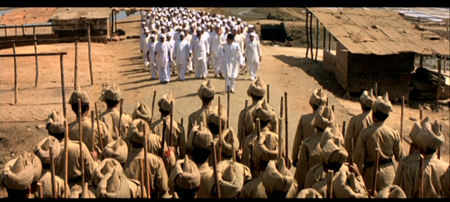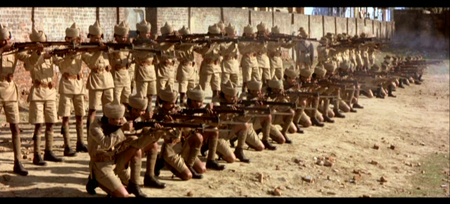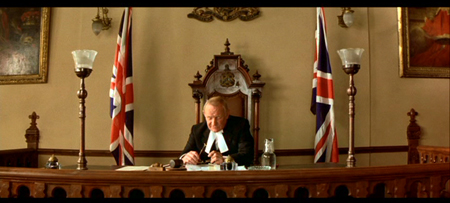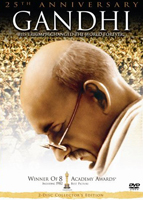BUY IT AT AMAZON: CLICK HERE!
STUDIO: Columbia
MSRP: $24.96
RATED: PG
RUNNING TIME: 191 Minutes
SPECIAL FEATURES:
• Commentary by dir. Richard Attenboroug
• Introduction by Richard Attenborough
• Vintage newsreel footage
• Interview with Sir Ben Kingsley
• Nine production and history featurettes
The Pitch
"It’s
the dignity of the entire human race as exemplified by a single man."
"Will
people watch that?"
"Yes.
But they’ll say it’s boring."
The Humans
Sir Ben
Kingsley, with a little help from Edward Fox, Candice Bergen, John Gielgud, Martin Sheen, and a few thousand extras.
The Nutshell
If you
don’t know the story of Mohandas Gandhi, please educate yourself before you
accidentally waste any more time here. On this planet, I mean.

In his younger, wilder days, Mohandas used his ‘do
to express his counterculture tendencies.
The Lowdown
I’ve been
lucky enough to get assigned the good biopics this year. First was Oliver
Stone’s The Doors, and now Attenborough’s austere masterpiece. I know there
isn’t much of a equal comparison between Jim Morrison and Mohandas Gandhi, but
the quality of the film shouldn’t rely upon the morality of the subject. That’s
the rule, anyway. The filmmaking and the historical figure are separate
entities, and criticism of the former needn’t involve consideration of the
latter beyond the scope of the film. However, I’m finding it difficult to keep
the two from combining, given my immense respect and admiration for the person
of Gandhi. I wanted to get that out of the way up front, so you can color the
rest of the read as appropriate.
Also,
while I’m being a bad critic, I’d also like to mention that watching Gandhi
immediately after watching 300 — both records of great
victories, of sorts — ranks among the strangest juxtapositions I’ve ever
experienced, landing just above that time I saw one of my grade school teachers
outside of the classroom.

The Siberians arrived in full camouflage.
Some
discussion of Gandhi’s character may be appropriate for discussion in a review
like this, of course, because the character defines the film, rather than the
directorial style. Director Richard Attenborough does nothing more ostentatious
in the structure than a bit of Ouroboros time manipulation, setting the scene
with the climactic assassination of the protagonist. Apart from that, the
structure is linear, the style as austere as an ascetic’s life. To contrast,
take The
Doors, in which Stone employed numerous manipulations of the camera’s
vision to communicate directly the experiences of the characters; in Gandhi,
Attenborough keeps everything finely ordered.
It’s a
method of unobtrusive filmmaking that served David Lean well in everything he
did, most notably Lawrence of Arabia. The notable difference is that where Lean
structured a plot and adventure, Attenborough constructs an argument. It’s a
grand argument, involving human nature and civil order, but it makes its
progression from idea kernel to lofty idealism by a series of steps that anyone
with the attention span can follow. The structure reminds me of Swift’s
"Modest Proposal," in that easily acceptable axioms are gradually
stacked atop each other to reach the inescapable conclusion, only Attenborough
shoots for something beyond satire, and, as far as I know, doesn’t advocate the
eating of babies. As such, Gandhi is a highly successful
propaganda piece, but try and take that word without negative connotation.

[Tarzan noise]
The
argument is built on the person of Gandhi, who had deep religious and personal
belief in a philosophy of peace, a sort of "do no harm" approach to
life. As an ethical core, it provides a solid foundation for everything that follows.
As Gandhi’s experiences are layered through the first hour of the film, the
philosophy expands from doing no harm to a social righteousness that suggests such
an ethical stand ought to be adopted by everyone. What impresses most people
about Gandhi is revealed at this point: though his philosophy included other
people, especially those who were not like-minded, it did not at any time advocate
the forceful conversion of ideologies. Quite the opposite, in fact.
So, with
bloody conversion left out, and an ethical engine that owed more to sociology
than to Hinduism, what was Gandhi to do? For his life’s defining struggle, the
fight for Indian independence which occupies most of the film, the logical
progression is toward civil disobedience and non-cooperation. Such actions were
at once non-threatening and without capitulation, no easy feat in these days or
any. Gandhi espouses a method of rebellion that stands as the academic’s dream:
the combat of discourse, with no casualties but words spent. It’s at this point
that Attenborough’s argument crystallizes: logic and reason build to compassion
and order. Religious fervor needn’t drive the quest for peace when human
restraint and decency naturally flow in that direction. It’s a philosophy
culled from Gandhi’s life, and projecting it back upon his character makes for
an uncomplicated, but compelling, thesis. It is reasonable to treat your fellow
humans with dignity; it is logical to extend courtesy and fairness to those you
come into contact with.
Whether
your political ideologies support, diverge from, or contradict Gandhi’s,
Attenborough’s expertise at the debate of ideas provides an exemplary film of
logical progression. If you can accept the proposition that Gandhi was a human
being, then you can accept each further proposition as stemming from the one
before it.

The British army needed a division of hunchbacks to fill in the middle level.
I’ve
discussed the meat of the film, but, as mentioned, the plot does resolve to a
dissonant chord with Gandhi’s assassination. Where does that event fit in with
Attenborough’s logic? It is included for the sake of completeness, sure, but
the act and the political Goldberg machine that led to it act as one last
tactic in Attenborough’s bag of debating tricks: the deconstruction of counter
argument. It’s something of a trick; an extreme rebuttal (almost a straw man) enters
the arena only when Attenborough is good and ready to defeat it. A philosophy that
contradicts Gandhi’s can not co-exist alongside the man’s own without creating
strong agitation. Agitation impedes the growth of an ideal, except in the rare
cases that a dissenting voice is silenced entirely.
Gandhi‘s logical constructs remind me of
near-perfect geometry. It’s a film assembled from base materials, reaching to
the very top of idealism, well-made and strong. I am consistently awed by its
eloquence and its craftsmanship. Eventually, it leaves me speechless. And
reminds me that, fuck, I’m an awful person.
Thanks a
lot, Gandhi.
The Package
The
re-mastered print, in full 2.35:1 widescreen, is worth mentioning here because
the visuals aren’t frequently cited as one of the film’s strong points, given
the weight of other material to praise. While Attenborough and his DPs, Billy
Williams and Ronnie Taylor, weren’t shooting for the epic look, the scope of
Gandhi’s journey is frequently caught in manipulations of scope and deep fields
of view.
The
soundtrack has also been remastered, so you can groove to Ravi Shankar’s tunes
(and George Fenton’s score) at floor-rumbling volumes. I can’t comment on the
any fidelity improvement, since I’ve only ever seen the VHS copy of the film,
which obviously isn’t as good.

"I miss my wig."
The two
discs are filled nicely to the brim, with a humble introduction to the film and
full-length commentary by Attenborough. The man has frequent insight, and his
mood matches that of the film pretty closely. It didn’t occur to me how unusual
that is until I was closed to finished with the track. Usually, commentators
veer toward humor as they recount the obstacles of their filmmaking processes,
but Attenborough comes off as a sober fellow. There’s nothing critical to say
about that; it’s just interesting.
The
second disc features an in-depth interview with Sir Ben Kingsley on the
preparation and effort he put into recreating the character of Gandhi. If
you’re familiar at all with acting methods, there are no revelations, but
Kingsley is generous with his experiences.
A number
of vintage newsreels are also included, documenting the events of the
historical Gandhi’s life. Collectively, they make my favorite bonus in the set,
because they are so much of the time; they provide a deeper connection between
audience and source material.
There are
a further nine recently-produced featurettes on the second disc, none of which
are especially long. They include: "In Search of Gandhi,"
"Reflections on Ben," "Madeleine Slade: An Englishwoman
Abroad," "The Funeral," "Looking Back," "Shooting
an Epic in India," "Designing Gandhi," "From the Director’s
Chair," and "Words of Mahatma Gandhi." There is no subterfuge
here; the titles explain exactly what you’re going to see. It’s a wealth of
information, despite the relatively brief time given to each subject, and the
historical and biographical featurettes are welcome.
This set
is a fine celebration of the silver anniversary for Gandhi, which is in turn
a fine celebration of the ideals that have imprinted Gandhi’s name and manner
on the world’s shared memories.
8.8 out of 10
